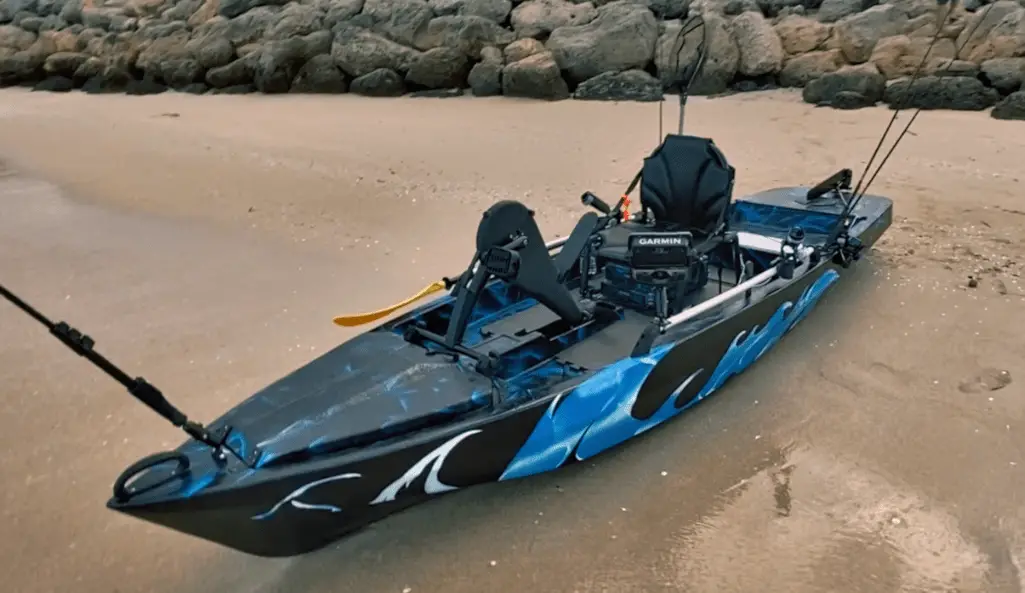
Paddlers are constantly tweaking their ride to make the most of their over-water adventures. But what do you do when fine-tuning isn’t cutting the mustard? You’ve got two options; trade up, or start from scratch. It takes real gumption and dedication, along with a boatload of skill and patience, to build your own kayak. And then it takes all that and then some to try and build a DIY pedal kayak.
We’re proud to present one of the best builds we’ve come across in recent times for both its ingenuity and execution. At first glance the CHK 3.6 looks like a tricked out Pro Angler. Only after a second look do you realize that it’s actually a custom built fishing machine. Read on below to learn more about the one of a kind CHK 3.6.
Meet the Builder
Arniel Consolacion hails from the Phillipines but has called Perth, Australia home for the last 15 years. As a professional shipwright and metal fabricator with over thirty years of experience he knows a thing or two about building boats. Fed up with the poor performance and heavy weight of his fishing rig Arniel opted to craft a lightweight and stable kayak for angling in the Indian Ocean. A few months later and the Custom Homemade Kayak, or CHK, was ready for the champagne bottle. We had the opportunity to chat with this jeproks kayak angler and learn more about his process throughout the build.
Around how much did The Project Cost?
The total cost was around $400 AUD. Glassing materials and plywood made up the bulk of the BOM. I was able to save by recycling several components from other boats and builds. It also helps to be creative. For example I used aluminum broom handles as the accessory rails on the gunwales. They’re strong, light, and roughly the same dimension as Hobie H Rails; so clamp-mount accessories attach no problem.
What Inspired You to Build the CHK 3.6?
| Length | Width | Weight | Capacity |
|---|---|---|---|
| 11'9" | 38" | 64 lbs | 550 lbs |
I owned a 2.7m long rotomolded kayak with a padded seat that wasn’t very comfortable. On long treks out my legs would be cramp and there was really no way to stretch out. It was also very difficult to cast perpendicular to the boat; and water would constantly splash over leaving me wet and chilled. I wanted a higher seat and more stable hull to solve these issues but wasn’t thrilled about the high price of commercially available options. So I decided to try and put my skills to the test with a scratch built diy pedal kayak.
Is The CHK 3.6 Your First Build?
Actually the CHK is my fourth build, and the third made out of plywood. I used XPS foam for my first build and then graduated to plywood and glass for the subsequent three. The lessons I learned from those first projects were invaluable; and I was able to incorporate a lot of those refinements into the CHK.
How Long Did The Project Take?
To be honest I didn’t keep track of the total man hours. I mostly worked on it on nights and weekends over the Summer. My best guess is around 100 hours spread out over 2-3 months. The hardest part was the glassing – there are long dry times between layers and it’s just a pain in the butt to work with. Painting and adding accessories was probably the fastest part of the process.
So, How does the CHK Perform?
I had high expectations going into this project, but I was still surprised at how well it performed on the water. It tracks straight with a smooth glide and is incredibly responsive to the pedal drive thanks to the light weight. I can hit 5 mph with moderate effort and turning is easy with the drop down rudder. Stability is also awesome. Thanks to the wide beam and trimaran design I can stand on one side of the deck without wetting the rails. My first time out I caught a day’s limit of squid in half an hour; so I’ve been pretty happy with it so far.
What Advice Can You Offer Future Builders?
Haha that’s easy – have a plan. Seriously though take your time and really map out all of the features you want from your build, then work backwards from there. I’ve learned over my several builds that it’s a lot easier to adjust a project when it’s still on paper rather than trying to jerry-rig a solution half way through.
Other than that be sure to ask for help when you need it. I’ve had the benefit of working as a boat builder for most of my professional career. So I’ve got a better sense of hydrodynamics and how things fit together than a first time builder probably does. All that’s to say that if you don’t have those skills don’t try and wing it – it’s a lot easier to fix a mistake before its happened.
Learn More
If you’re interested in seeing more of Arniel’s build in detail then be sure to check out his youtube channel: Kustom DIY. Arniel has documented every step of the CHK 3.6 and these videos are an excellent resource if you’re considering your own diy pedal kayak build. He’s already got the next project on the rotary jig – the CHK V2 with an updated deck profile. Finally if you’ve got any questions about your own build feel free to reach out to Arniel on Facebook or Instagram.